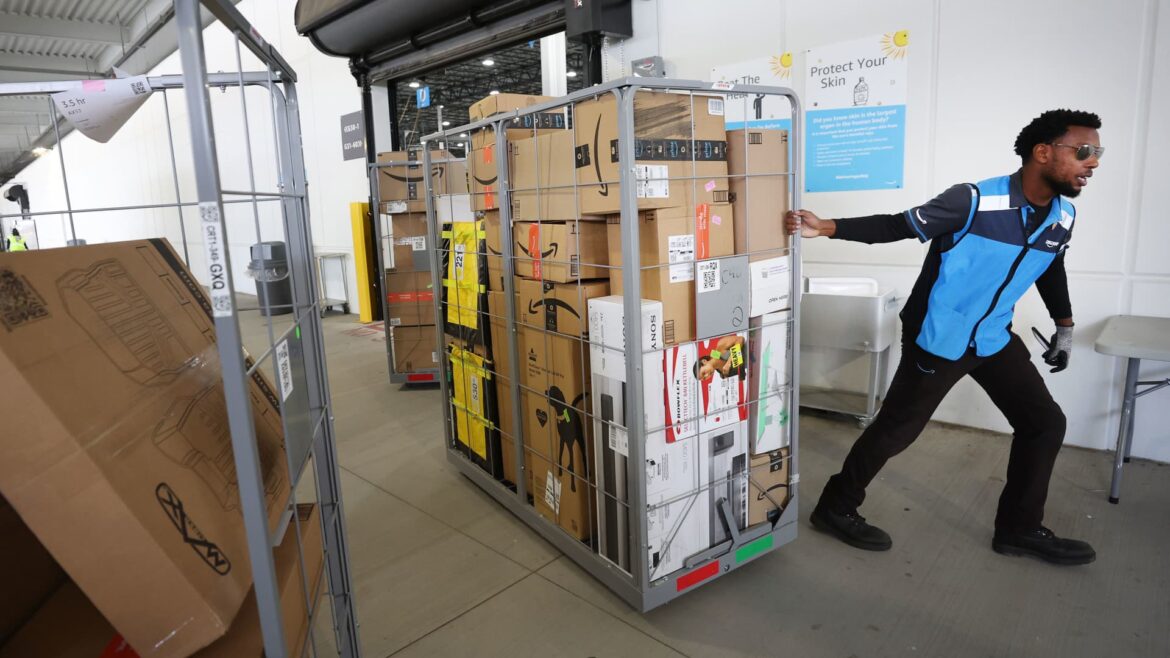 GAIMIN is creating the world’s largest GPU-based DePIN to address the increasing worldwide demand for data processing power. GAIMIN’s DePIN, called gaimin.cloud, currently focuses on delivering data processing services for Artificial Intelligence (AI), Video Rendering (VR) and the powering of blockchain computations. GAIMIN’s approach is based on users allowing their devices to participate in GAIMIN’s […]
GAIMIN is creating the world’s largest GPU-based DePIN to address the increasing worldwide demand for data processing power. GAIMIN’s DePIN, called gaimin.cloud, currently focuses on delivering data processing services for Artificial Intelligence (AI), Video Rendering (VR) and the powering of blockchain computations. GAIMIN’s approach is based on users allowing their devices to participate in GAIMIN’s […]
Source link
delivering
A Christmas tree stands in front of the New York Stock Exchange (NYSE) in New York on December 1, 2023.
Angela Weiss | Afp | Getty Images
In the final CNBC’s Delivering Alpha Stock Survey poll of the year, the 300 investors, traders and money managers surveyed are behind Jerome Powell and the Federal Reserve.
Eighty-eight percent give the Fed an excellent or good score for 2023, that’s better than the 77% from the survey three months ago. More than half believe they’ll start cutting rates in the second quarter of 2024.
Those surveyed are mostly planning to put their money in the S&P 500, with 28% saying that would be a main target for them in the new year. Sixteen percent said they’d mostly be investing in Nasdaq 100 stocks.
About 12% said China would have the strongest growth followed by Japanese stocks, high yield bonds, long range US bonds and bitcoin, all coming in 8% apiece. Not one person surveyed said gold would be their favored investment of 2023. The commodity is near record highs and up 15% in 2023.
Gold, YTD
In terms of sectors, 35% said financials would be the winner in the new year with 23% favoring high dividend stocks.
Still love the Magnificent 7
When asked what would do better in 2024, the “Magnificent 7” or the other 493 S&P stocks respondents were firmly behind the Magnificent 7 with 77% saying they’d do better cumulatively than the rest of the S&P 500. Of the tech basket, Microsoft was the clear favorite in the group with 44% saying they’d pick that stock first, Amazon was a distant second at 24%, followed by Nvidia at 12% after its big run in 2023. Alphabet, Apple, Meta and Tesla were all in single digits.
Big cap tech is the favorite area for investors looking to invest in AI according to the survey with 58% saying that’s where they’d put their money.
The big cap tech stock they were most behind was Microsoft at 39% followed by Nvidia at 35%, AMD at 13% followed by Amazon at 9% and Alphabet at 4%. While many analysts still like Oracle, that stock had zero percent support in the survey. Just a few months ago analysts were big backers, but according to FactSet only 14 of 27 now have a buy rating on the stock, 12 are neutral and one is a sell. Oracle which was touted as a great undervalued AI play is now 17% from the June high.
In case things get rough for the markets, 35% say money markets are the best place to be followed by 31% in U.S. bonds and 19% in plain old cash. Just 7% would choose gold, 4% for crypto and real estate.
Health care, energy, staples and utilities were the worst sectors of the year with utilities down 11% in 2023. The survey asked “which of 2023’s weakest sectors has the most upside potential in 2024?” Health care was the clear winner with 56% saying that had the best change of doing well. About 24% said energy stocks, 12% favored consumer staples and 8% picked utilities.
When it comes to the biggest risks for stocks in 2024, stubborn inflation and problems with commercial real estate ranked highest followed closely by slow growth. War overseas and a more militarily aggressive China scored 11% apiece.
In terms of the 2024 election, only 15% said it weighed “heavily” on their investing strategy in 2024 with 85% saying it would have little impact on their decision making.
Amazon says it’s delivering more packages in one day or less after overhauling delivery network
An Amazon driver loads packages into a delivery van at an Amazon delivery station on November 28, 2022 in Alpharetta, Georgia.
Justin Sullivan | Getty Images
Amazon has for years been marching toward making same-day and next-day delivery the standard for members of its Prime loyalty club.
On Monday, the company said it reached a major milestone in those efforts. Amazon said so far this year it’s delivered 1.8 billion units to U.S. Prime members the same or next day, roughly four times what it delivered at those speeds by this point in 2019.
For the past four years, Amazon has poured money and resources into revamping its warehouse and delivery network to shorten shipping times from two days to one day or less. Those efforts hit a snag during the Covid pandemic due to supply chain and labor-market challenges, but normal delivery speeds have largely returned as a result of new warehouses coming online and other improvements to the company’s operations.
Amazon says it achieved its “fastest Prime speeds ever” last quarter.
One of the company’s biggest changes in the past year is a shift away from a national “hub and spoke” fulfillment network, where packages might travel through several facilities across the country, said Udit Madan, Amazon’s vice president of transportation, in an interview. The company moved to a model in which the country is divided into eight smaller regions, with local facilities that stock commonly ordered items.
Fast delivery is notoriously expensive and logistically challenging, and companies typically lose money on deliveries. But Amazon’s change cut costs and boosted delivery speeds, Madan said.
“Our fastest speeds tend to be our most economical,” he said.
Driving fewer miles and requiring fewer handoffs has reduced Amazon’s “cost to serve,” Madan added. Amazon says it’s cut the distance items are traveling from warehouses to customers by 15%, and lowered the number of “touchpoints,” or how many times a package is handled, by 12%.
The company has also seen improvements in its machine-learning technology that allows it to better plan where and how much inventory is placed in warehouses, hastening delivery times. Across the top 60 U.S. metro areas, Amazon says more than half of Prime orders arrived the same or next day.
Speedier delivery has pushed shoppers to purchase more items from Amazon than they might normally buy from their local corner store, or big-box retailers like Best Buy.
“We’ve consistently seen that as we’re offering faster speeds, we’re actually expanding the consideration set that customers think of us for when they’re thinking about their purchases,” Madan said. “What we’re seeing is greater engagement and more purchases from customers.”
Amazon is rolling out more so-called “same-day sites,” or smaller buildings located closer to large metro areas where the company fulfills, sorts and delivers products from a single location. It has traditionally operated distinct facilities for these purposes, meaning separate fulfillment centers, sort centers and delivery stations.
Same-day sites are stocked with a rotating selection of millions of items tailored to what customers are purchasing in the area, whereas a typical warehouse is much larger and may have a more random assortment of products.
Amazon plans to double the number of same-day sites in its network over the next two years, Madan said.
The company declined to share how many same-day sites it maintains. The Wall Street Journal reported Amazon has opened approximately 45 facilities since 2019, citing data from MWPVL International, a supply chain and logistics consulting firm that closely tracks Amazon’s distribution network.
WATCH: Amazon’s global head of sports says, ‘We’re playing the long game’




